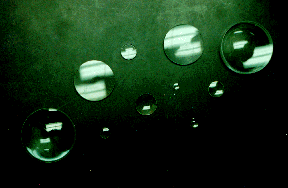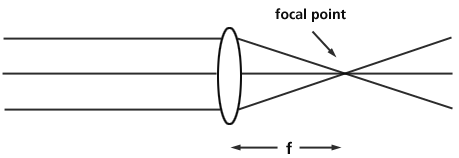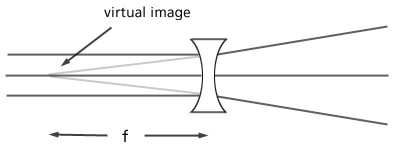Submodule 2: Lenses, Mirrors, and Prisms: Objective 2
Steve Beeson, Arizona State University

Explore the lenses marked A, B, and C in your Optics Discovery Kit. Write down some of your discoveries and observations.
How much does each lens magnify objects? Does the magnification change if you move the lens toward or away from the object? What about if you move toward or away but keep the lens in the same place? Again, write down some of your observations.
Where is the focal point?
Using the lenses in your Kit, try to image (focus) the light from a light bulb or fluorescent lamps onto a sheet of white paper. Do all the lenses image the light? If any don't focus the light, which ones are they?
If you could image the light bulb or lamp onto the paper, then you have found the focal length of that particular lens. The focal length, f, is the distance from the lens to the point where light rays incident on the lens come to a focus.

Here's an image of a convex lens in action.
The point where the light rays come to a focus is naturally called the focal point of the lens.
Another way to find the focal point of a lens is to actually place your eye at the
focal point of the lens.
Try to find the point at which everything through the lens goes completely "out of focus" and you can't even see an image (everything is blurred). Is the lens close or far
from the object you are observing? Do all the lenses seem to have a point where
they go completely out of focus?
 Click the book to read more about lenses and focal points.
Click the book to read more about lenses and focal points.
What is a "virtual image"?
The lenses A and B in your Optics Discovery Kit are called double convex lenses and have positive focal lengths. They have sides that bulge outwards and, as we saw above, converge light to a focal point.
What about lens C in your Kit? It's called a double concave lens and has a negative focal length. What do you think it does to light beams?
So we find that convex lenses converge light beams and concave lenses diverge light beams.
When you tried to image (bring to a focus) the room lights with the concave lens C earlier, did you get an image? Most likely not, since the concave lens, as we have seen, diverges light and can't bring light beams to a focus. The image, if there was one, would have been on the same side of the lens as the source (the light) unlike the convex lens.

This kind of image on the same side as the source is called a virtual image . It's an image that isn't really there; the focal point in the drawing above is just the point where the rays would converge if they could. We can't focus the beams onto a piece of paper, for instance like you tried earlier. The strange thing about a virtual image, however, is that we can see it!
So what kind of image does a convex lens make? The drawing below show us that a convex (positive) lens forms images on the side of the lens opposite of the source .

Since we can form an image on a piece of paper, we call this kind of image a real image. As you've probably guessed, we can also see real images.
 Click the book to read more about lenses and optics.
Click the book to read more about lenses and optics.
 What kind of instruments can we make with lenses?
What kind of instruments can we make with lenses?
 Modules
Modules
 Light & Optics
Light & Optics
 Submodule 2
Submodule 2
 Readings
Readings
 PiN Homepage
PiN Homepage
 ACEPT
ACEPT
 Glossary
Glossary
 Help
Help
 Top of the Page
Top of the Page